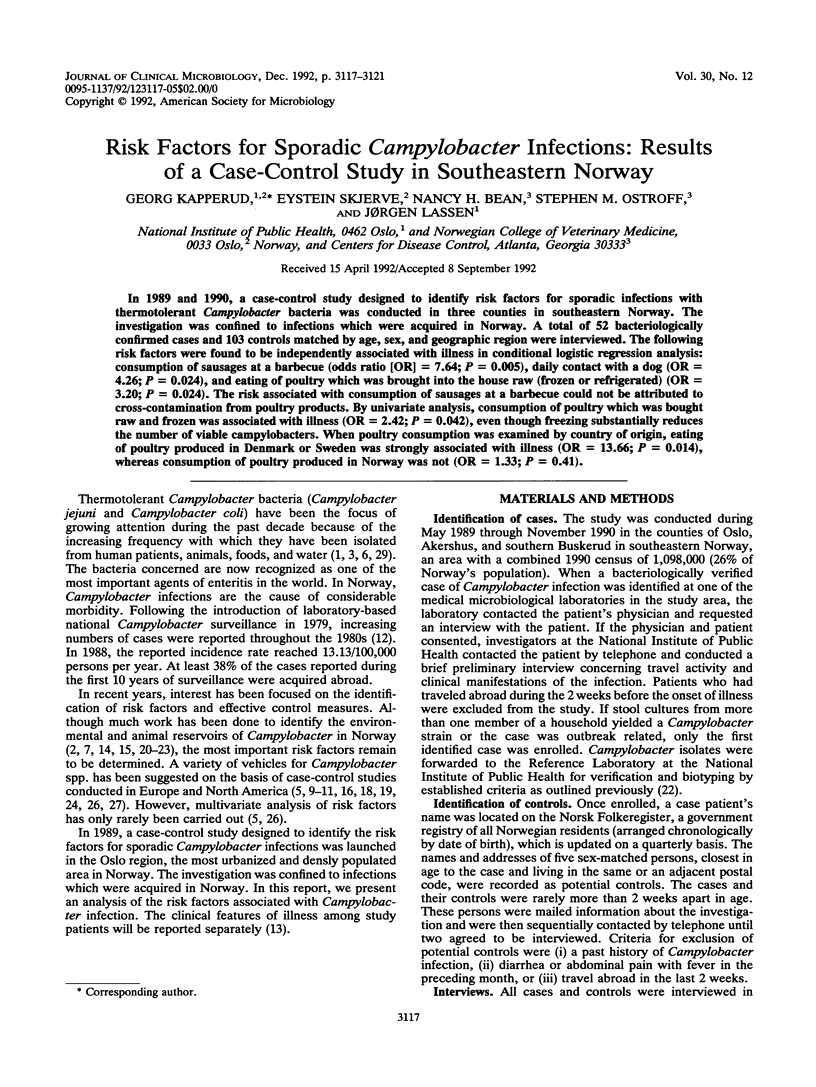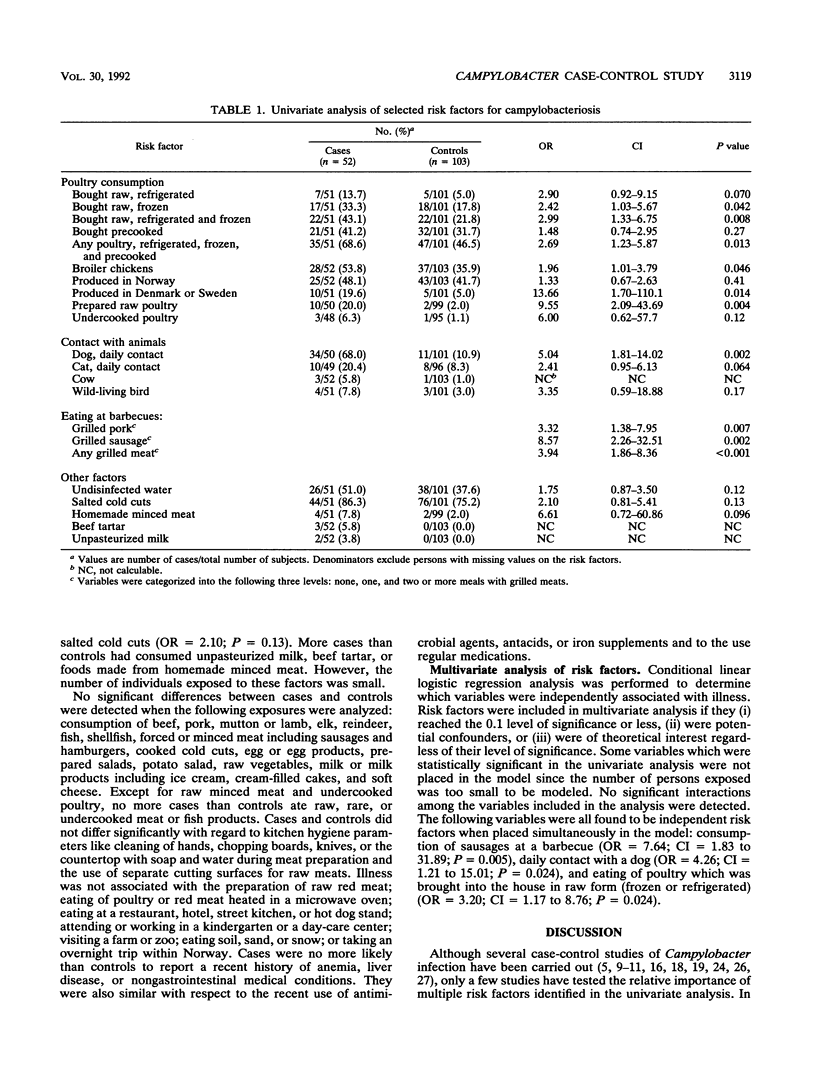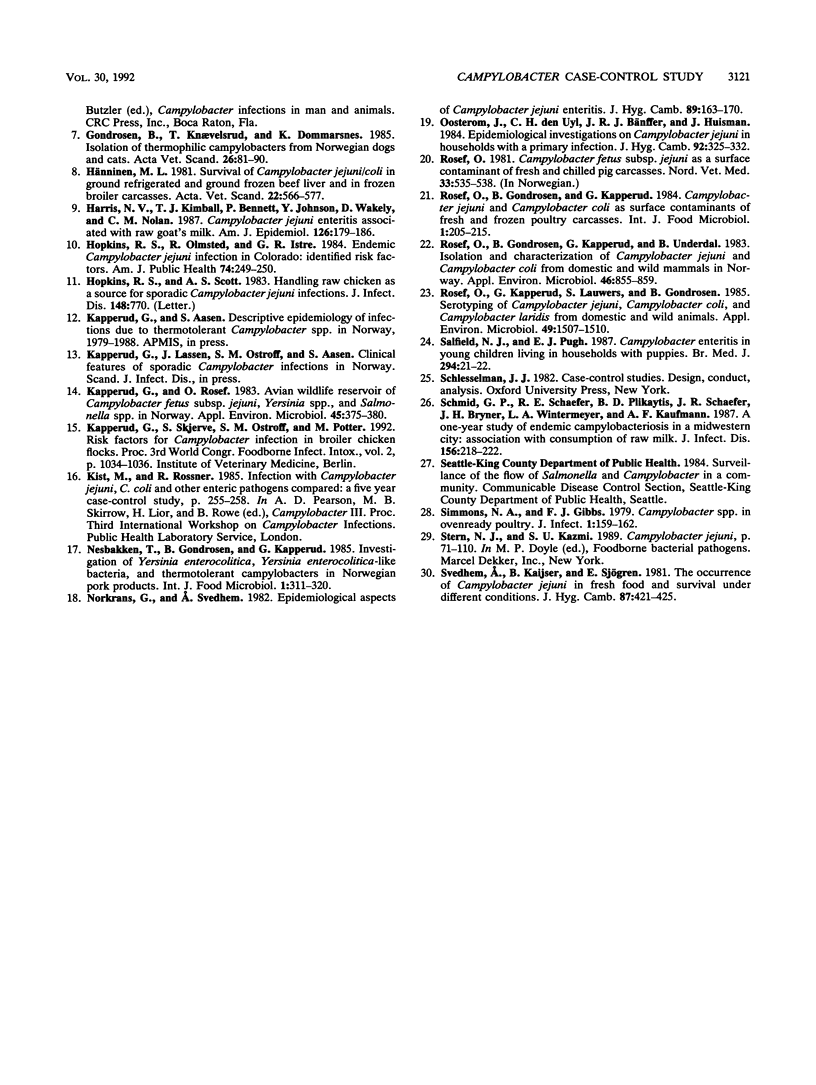Abstract
In 1989 and 1990, a case-control study designed to identify risk factors for sporadic infections with thermotolerant Campylobacter bacteria was conducted in three counties in southeastern Norway. The investigation was confined to infections which were acquired in Norway. A total of 52 bacteriologically confirmed cases and 103 controls matched by age, sex, and geographic region were interviewed. The following risk factors were found to be independently associated with illness in conditional logistic regression analysis: consumption of sausages at a barbecue (odds ratio [OR] = 7.64; P = 0.005), daily contact with a dog (OR = 4.26; P = 0.024), and eating of poultry which was brought into the house raw (frozen or refrigerated) (OR = 3.20; P = 0.024). The risk associated with consumption of sausages at a barbecue could not be attributed to cross-contamination from poultry products. By univariate analysis, consumption of poultry which was brought raw and frozen was associated with illness (OR = 2.42; P = 0.042), even though freezing substantially reduces the number of viable campylobacters. When poultry consumption was examined by country of origin, eating of poultry produced in Denmark or Sweden was strongly associated with illness (OR = 13.66; P = 0.014), whereas consumption of poultry produced in Norway was not (OR = 1.33; P = 0.41).
Full text
PDF




Selected References
These references are in PubMed. This may not be the complete list of references from this article.
- Blaser M. J., Taylor D. N., Feldman R. A. Epidemiology of Campylobacter jejuni infections. Epidemiol Rev. 1983;5:157–176. doi: 10.1093/oxfordjournals.epirev.a036256. [DOI] [PubMed] [Google Scholar]
- Butzler J. P., Skirrow M. B. Campylobacter enteritis. Clin Gastroenterol. 1979 Sep;8(3):737–765. [PubMed] [Google Scholar]
- Deming M. S., Tauxe R. V., Blake P. A., Dixon S. E., Fowler B. S., Jones T. S., Lockamy E. A., Patton C. M., Sikes R. O. Campylobacter enteritis at a university: transmission from eating chicken and from cats. Am J Epidemiol. 1987 Sep;126(3):526–534. doi: 10.1093/oxfordjournals.aje.a114685. [DOI] [PubMed] [Google Scholar]
- Gondrosen B., Knaevelsrud T., Dommarsnes K. Isolation of thermophilic Campylobacters from Norwegian dogs and cats. Acta Vet Scand. 1985;26(1):81–90. doi: 10.1186/BF03546566. [DOI] [PMC free article] [PubMed] [Google Scholar]
- Harris N. V., Kimball T. J., Bennett P., Johnson Y., Wakely D., Nolan C. M. Campylobacter jejuni enteritis associated with raw goat's milk. Am J Epidemiol. 1987 Aug;126(2):179–186. doi: 10.1093/aje/126.2.179. [DOI] [PubMed] [Google Scholar]
- Hopkins R. S., Olmsted R., Istre G. R. Endemic Campylobacter jejuni infection in Colorado: identified risk factors. Am J Public Health. 1984 Mar;74(3):249–250. doi: 10.2105/ajph.74.3.249. [DOI] [PMC free article] [PubMed] [Google Scholar]
- Hopkins R. S., Scott A. S. Handling raw chicken as a source for sporadic Campylobacter jejuni infections. J Infect Dis. 1983 Oct;148(4):770–770. doi: 10.1093/infdis/148.4.770. [DOI] [PubMed] [Google Scholar]
- Hänninen M. L. Survival of Campylobacter jejuni/coli in ground refrigerated and in ground frozen beef liver and in frozen broiler carcasses. Acta Vet Scand. 1981;22(3-4):566–577. doi: 10.1186/BF03548680. [DOI] [PMC free article] [PubMed] [Google Scholar]
- Kapperud G., Rosef O. Avian wildlife reservoir of Campylobacter fetus subsp. jejuni, Yersinia spp., and Salmonella spp. in Norway. Appl Environ Microbiol. 1983 Feb;45(2):375–380. doi: 10.1128/aem.45.2.375-380.1983. [DOI] [PMC free article] [PubMed] [Google Scholar]
- Norkrans G., Svedhem A. Epidemiological aspects of Campylobacter jejuni enteritis. J Hyg (Lond) 1982 Aug;89(1):163–170. doi: 10.1017/s0022172400070662. [DOI] [PMC free article] [PubMed] [Google Scholar]
- Oosterom J., den Uyl C. H., Bänffer J. R., Huisman J. Epidemiological investigations on Campylobacter jejuni in households with a primary infection. J Hyg (Lond) 1984 Oct;93(2):325–332. doi: 10.1017/s002217240006486x. [DOI] [PMC free article] [PubMed] [Google Scholar]
- Rosef O., Gondrosen B., Kapperud G., Underdal B. Isolation and characterization of Campylobacter jejuni and Campylobacter coli from domestic and wild mammals in Norway. Appl Environ Microbiol. 1983 Oct;46(4):855–859. doi: 10.1128/aem.46.4.855-859.1983. [DOI] [PMC free article] [PubMed] [Google Scholar]
- Rosef O., Kapperud G., Lauwers S., Gondrosen B. Serotyping of Campylobacter jejuni, Campylobacter coli, and Campylobacter laridis from domestic and wild animals. Appl Environ Microbiol. 1985 Jun;49(6):1507–1510. doi: 10.1128/aem.49.6.1507-1510.1985. [DOI] [PMC free article] [PubMed] [Google Scholar]
- Salfield N. J., Pugh E. J. Campylobacter enteritis in young children living in households with puppies. Br Med J (Clin Res Ed) 1987 Jan 3;294(6563):21–22. doi: 10.1136/bmj.294.6563.21. [DOI] [PMC free article] [PubMed] [Google Scholar]
- Schmid G. P., Schaefer R. E., Plikaytis B. D., Schaefer J. R., Bryner J. H., Wintermeyer L. A., Kaufmann A. F. A one-year study of endemic campylobacteriosis in a midwestern city: association with consumption of raw milk. J Infect Dis. 1987 Jul;156(1):218–222. doi: 10.1093/infdis/156.1.218. [DOI] [PubMed] [Google Scholar]
- Svedhem A., Kaijser B., Sjögren E. The occurrence of Campylobacter jejuni in fresh food and survival under different conditions. J Hyg (Lond) 1981 Dec;87(3):421–425. doi: 10.1017/s0022172400069667. [DOI] [PMC free article] [PubMed] [Google Scholar]


